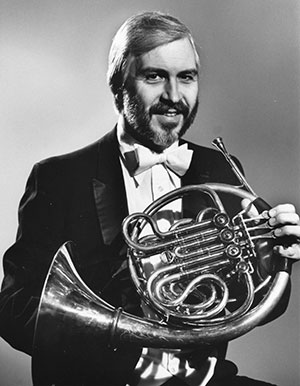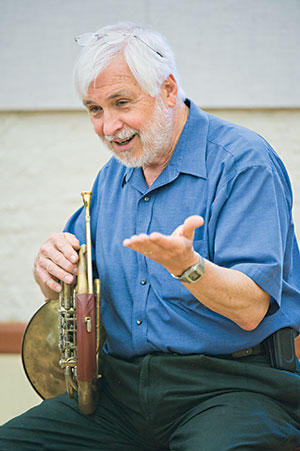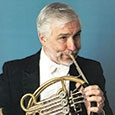Legendary horn player Dale Clevenger died on January 5, 2022, at the age of 81. Clevenger’s remarkable musical career included 47 years as principal horn of the Chicago Symphony Orchestra, beginning when he was just 25. He was born in Chattanooga, where he played in the high school band of noted band director, A.R. Casavant. Clevenger contributed to our pages several times over the decades. We reprint selected excerpts from his articles as a tribute to our friend.
Becoming a Professional
To be professional takes talent, drive, motivation, single-mindedness of purpose, tunnel vision, and compulsion. It takes excellent schooling, the best that one can get. It is rare that those who are self-taught become professional musicians because they lack discipline, whether tonal, intonational, or personal. Even with excellent education, it is a matter of having the good luck to be at the right place at the right time. All these together still are no guarantee of success, because you have to play an audition well.

Preparation for an audition is a major ingredient in being able to play at an audition at a given moment, the first time through. Just as in concerts, there is no chance to stop and play the solo again. The concept of playing something without stopping is foreign to many students who, whenever they make a mistake, grunt, frown, roll their eyes, or quit playing. It is extremely important to break the habit. Organize practicing to fix this problem; play for an hour without stopping for anything. Play right on through no matter what. Then play for another thirty minutes, and stop for everything that is wrong.
Concentration can overcome nervousness. Rather than think about whether you are going to miss a note, or what people think, try to get rid of the what ifs. Think about tone, line, effect, and the artistic purpose. I heard a fellow play a solo today, and I said, “Imitate me; I’m going to do something a little different.” I used a lot of vibrato and that kept him from thinking about missing notes or getting through the solo. An instrument is a powerful stimulus; once it comes in front of your face, all the habits, good or bad, that you have will appear. You try to replace those habits, but you don’t get rid of them. They are still in your brain, but you cover them with better habits, thought processes, concentration, and different ways of doing things. Instead of playing straight tones all the time, play with a vibrato. Play a melody on a mouthpiece. Do anything you can to make your thinking artistic rather than technical. Concentrate on playing phrases; plan a sequence of phrases. When you can do that well, you will be able to play despite little things that might go wrong.
There are people who audition well, but they cannot play with an ensemble. Others do poorly in auditions but play well in an orchestra. Nobody plays perfectly, only as perfectly as the concept in their head. I try to mirror what is in my brain as closely as I can.
The Instrumentalist, May 1992
What led to your joining the Chicago Symphony?
I had no serious thoughts about playing in the Chicago Symphony until after college, when I placed well in several auditions. However, I failed to win a position in eight or nine auditions for other orchestras before I played in Chicago.
Nobody made it after the first round of auditions, but I was invited back. I later learned that I had a little assistance from Alfred Wallenstein, one of the guest conductors, who said to then-conductor Jean Martinon, “You need to listen to this young man, and if he has already played for you, you need to listen closer.” In addition, Leopold Stokowski wrote a letter of recommendation.
In January 1966 I played a second audition and was invited to join the Chicago Symphony Orchestra on February 6th at age 251⁄2. Those were indescribable moments, the happiest times of my life because I knew that I would be doing something I had dreamed about since I began playing the horn, and especially since high school.
The high school lunch room was underneath the auditorium, and behind the lunch room was the band room. Most band members ate their lunches there and listened to recordings of the Chicago Symphony under Fritz Reiner. Our band director, A.R. Casavant, encouraged this, and I had the sound of the Chicago Symphony firmly in my head long before I ever got out of high school.
The Instrumentalist, August 2013
On Technique and Practicing
Technique is largely conditioned reflex. Many students and professionals never learn that to the extent they should. I discovered ten years ago that I somehow came up short in playing the chromatic scale. I had not spent enough time on it as a student and found myself faltering on the technique of a chromatic scale in the piece I was playing. I thought, “This is wrong; I should know this already.” For ten or thirty minutes a day I practiced chromatic scales until I learned them. Now I work to play them as musically as possible; I am not concerned about finding the next note. There is a time and a place for compartmentalizing your practice; I tell students to never play a note without meaning or purpose if they want to be a professional.
I don’t have regular daily exercises. Some days I begin a rehearsal, although not a concert, without having played at all. The first note I play is on the job. I want to see if I can do it, and of course I can, even though I don’t feel the same as if I had warmed up for ten or thirty minutes.
I play by sound. The physical feeling is not a primary criterion, but how I sound is. If I am going to play a major work, I pace myself carefully. When I warm up, I think in terms of quality tones; I play everything from staccato to long notes, thinking primarily of quality. I rarely go through routines or rote. Whatever note, length, or volume I play, it has to have quality. I don’t play long tones, I don’t play short tones, I play quality tones.
Jacobs says a way to practice getting the center of a note is to start out by just getting a note, without accuracy being too important. Once you get the note, then think in terms of quality, roundness, thickness, thinness, or whatever you want. Don’t worry about the ending of the note but that middle section of the note. I practice the lengths of notes that are in the pieces that I am playing.
I practice and teach the ability to start a long tone or play staccato without tonguing. Tonguing is the biggest problem in playing staccato, so eliminate it. Don’t tongue, go phooh. Do it very short, a little longer, whatever. It is analogous to how string players bow. They can play a spiccato by bouncing the bow off the string, or they can play staccato on the string. In a leadership position, I set the pace; if my section does not play the kind of staccato that I want, I will tell them, “Let’s not play quite so clipped. Don’t cut off the note with your tongue.” It may not sound that much different out in the audience, but it sounds better close up.
Let a note ring, however long, rather than cause it to ring. To play tah is one kind of sound and may be used in certain situations, but taaahh sounds so much better. What technique to use is dictated by the desired effect. If I hear anybody else in the orchestra play an effect that I like better, I’ll imitate that, and vice versa. I’ll make mine more pointed if I don’t like what I hear.

The Instrumentalist, May 1992
Working with Beginners
After buzzing only the mouthpiece for about five to ten minutes, a beginner should put the mouthpiece in the horn and play a whole note. The note can be a C, E, G, or even a low G (horn pitch), whatever comes out most readily. Watch that the mouthpiece does not slide downward; this is the natural effect of gravity on the horn in the hands of a small child. When a student appears for the second lesson, the embouchure will probably have moved down from 2/3 upper lip to half upper and half lower lip. Move it back up and emphasize the importance of practicing in front of a mirror to verify that the mouthpiece is where it should be. If a student knows this is likely to happen and looks out for it, the odds are improved that a good embouchure placement will emerge.
When adding the horn to the mouthpiece, a student should hold the horn with the left hand while the right hand holds the bell. If a student can reach around to put the right hand into the bell, the fingers should be fairly stiff and nearly flat in the bell, not curved.The shape should look like a handshake or a soft karate chop. The top of the thumb should touch the top of the bell as the bottom of the hand rests on the bottom of the bell.
A good reminder is to put two or three pieces of tape on top of each other inside the bell to form a ridge the student can feel. The objective is to line up the top part of the tape with the thumb touching inside the bell. This way the student can feel if the right hand is inserted too far inside the bell.
Phil Farkas has said that a player has the best hand position if when he moves inward a half inch, it will be too far and give a closed sound, while if the hand is moved out a half inch, it will not affect the sound at all. It is better for the hand to be too far out than too far in. The hand position is less important than a good embouchure during the early stages of horn study. A very small student should just put the right hand on the outside of the bell to hold the instrument steady.
First Lessons on Each Instrument, 1999
In the mid-1990s Dale Clevenger visited his son at a Boy Scout camp in the wilds of Northern Wisconsin. The camp was divided into two segments, one on either side of a lake. At sunset both camps held flag lowering ceremonies followed by Taps, played by a fledgling bugler who played with a feeble but well-intentioned sound.
All of this changed one evening when the woods resonated with the full-throated sound of a master bugler. Everyone on the other side of the lake stopped in their tracks and looked in the direction of this wondrous sound. The next day it emerged that Dale, ever the teacher, had given a demonstration of the fine art of brass playing for everyone.
– James T. Rohner, Publisher Emeritus
Dale came out to Pocatello, Idaho to play with the orchestra and was also scheduled to give a two-hour masterclass sponsored by the symphony at the local university. When he arrived, I think he was surprised to see about 100 or so junior high and high school French horn players. The first student got up to play. He was scared silly. Dale noticed that and stuck out his left arm and said, “Touch me. I am human. I make mistakes.” They both smiled, and the student calmed down.





